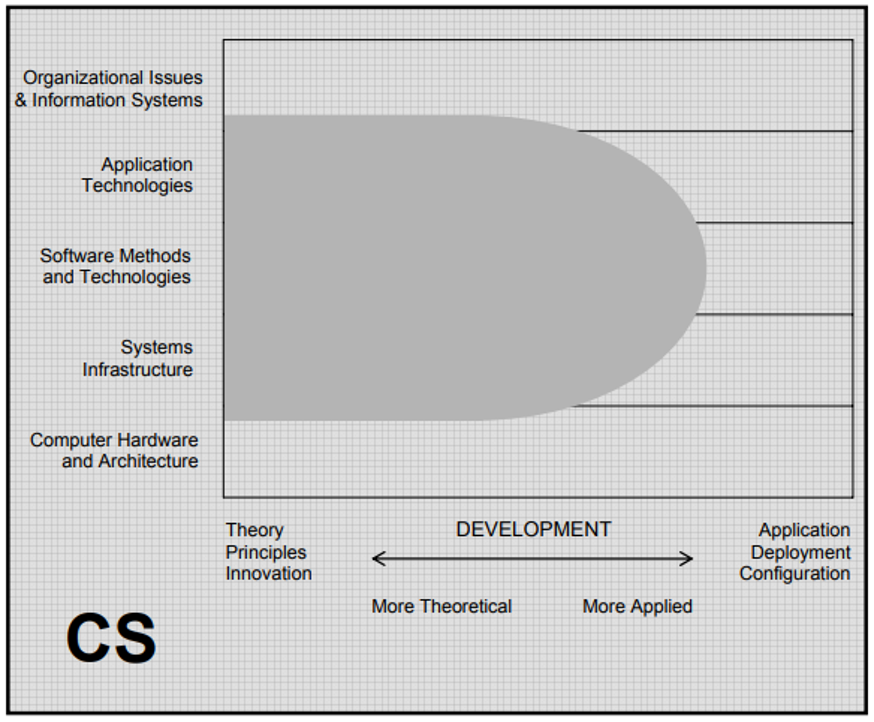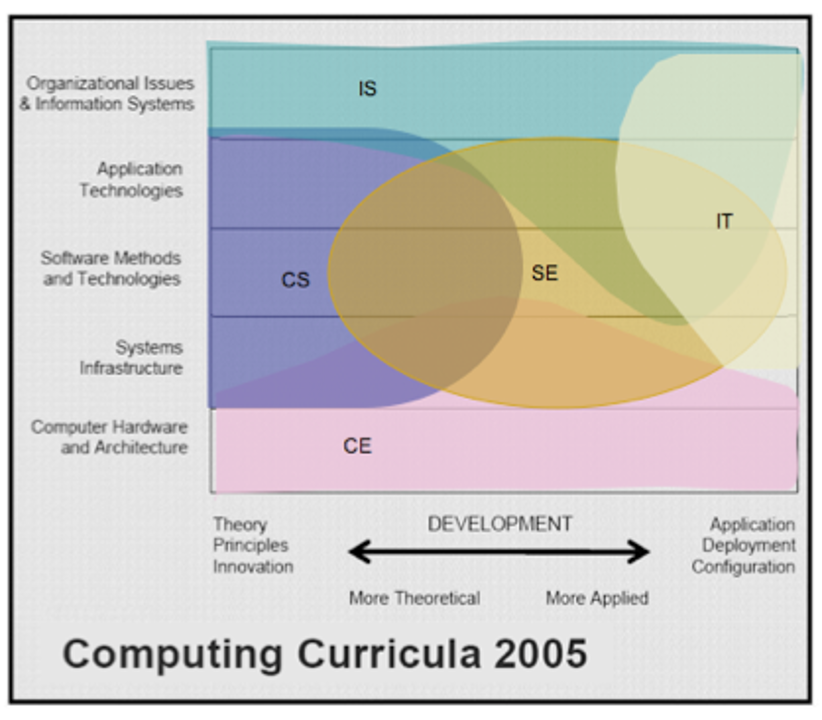Computer Science as Discipline, Computing Disciplines and Majors
Computer Science as Discipline
The dictionary defines discipline as a field of study. Peter Denning defines the discipline of computer science as “the body of knowledge and practices used by computing professionals in their work.... This discipline is also called computer science and engineering, computing, and informatics” (Dale & Lewis, 2002). He continues, “The body of knowledge of computing is frequently described as the systematic study of algorithmic processes that describe and transform information: their theory, analysis, design, efficiency, implementation, and application. The fundamental question underlying all of computing is, What can be (efficiently) automated?” (Dale & Lewis, 2002).
Computer science focuses on algorithm design, data structures, computational theory, and practical applications like AI, networking, and cybersecurity. Algorithms are fundamental to computer science because they form the basis of programming and software development. Data structures like arrays and trees optimize data management and access, while computational theory explores the limits of computation through models like Turing machines. AI and machine learning demonstrate practical applications of these concepts. Networking facilitates communication between devices, and cybersecurity ensures data protection (Huys, 2024).

The shaded portion in the figure highlights the broad scope of computer science, which spans from hardware and software development to information systems. Computer scientists work on creating a wide range of software but do not typically engage in managing or deploying these technologies, which is why the shaded area narrows on the right (ACM, AIS, & IEEE-CS, 2005).
Computer science provides an intellectual foundation supporting the information technology industry, the worldwide digital economy and the information society (Xu & Zhang, 2021). Computer science's relevance spans multiple industries, driving innovation and efficiency in modern life (Huys, 2024). The fundamental questions of concern to computer scientists range from foundations of theory to strategies for practical implementation (Henderson, 2009). Computer scientists primarily work on software development, either at the practical level or the theoretical, with the hope that every subject that begins as theoretical ends as practical (Spraul & Masse, 2005).
Five Computing Disciplines and Majors

1. Computer Engineering
2. Computer Science
3. Information Systems
As an academic field, information systems study how people and organizations use networks of hardware and software to collect, process, and distribute data. involve the creation, sharing, and distribution of data generated by computers and users. Common types include operation support systems, management information systems, decision support systems, and executive information systems. While professionals in this field work with computers and software, their focus is extracting data from various sources, such as servers or the internet, to complete tasks (CityU of Seattle, 2020).
4. Information Technology
To define information technology in a nutshell, it is the art and the technology of acquiring, storing, structuring and managing the information; compressing and transmitting the information; and finally, processing, accessing and interpreting this information. Information technology may be viewed as a discipline which has evolved out of the marriage between telecommunications and computing technologies (Ray & Acharya, 2004).
5. Software Engineering
According to the Institute of Electrical and Electronics Engineers (IEEE), software engineering is defined as 'the application of a systematic, disciplined, quantifiable approach to the development, operation, and maintenance of software; that is, the application of engineering to software.' In a nutshell, software engineering can be defined as a systematic approach to develop software within specified time and budget. (Khurana, 2010)
Analysis/Reaction
Trying my best to avoid plagiarism and simply copying text from websites and Wikipedia, I found it challenging to research specific information from published material, particularly from books and journals available online. Although I am not a bookworm, I came across many interesting books in various fields, not limited to computer science, from which I collected valuable information for this portfolio. Literature on computer science and the other five computing disciplines is abundant in this digital era, leaving no excuse for not learning.
From this activity, I learned that computer science is far more than just programming—it involves a comprehensive study of algorithms, data structures, computational theory, and real-world applications like AI, networking, and cybersecurity. These foundational concepts drive innovation across industries and enable the efficient automation of processes. I now understand that computer science supports the global digital economy and plays a crucial role in improving various aspects of modern life. The field spans both theoretical and practical domains, with the ultimate goal of using technology to solve real-world challenges and foster positive societal change.
In addition, this activity broadened my perspective on the different disciplines of computing. Previously, I thought computer engineering, computer science, and software engineering referred to the same discipline. However, I realized that they are distinct fields with specific goals, though they share some overlapping similarities, such as the development of computer software and hardware to meet organizational objectives and solve real-world problems, including information systems and information technology.
References
Association for Computing Machinery (ACM), & IEEE Computer Society. (2016). Computer engineering curricula 2016: Curriculum guidelines for undergraduate degree programs in computer engineering. ACM and IEEE. https://www.acm.org/binaries/content/assets/education/ce2016-final-report.pdf
CityU of Seattle. (2020, January 16). Information technology vs information systems: What's the difference? CityU of Seattle. https://www.cityu.edu/information-technology-vs-information-systems/
Dale, N., & Lewis, J. (2002). Computer Science Illuminated. Jones and Bartlett Publishers.
Denning, P. J., Comer, D. E., Gries, D., Mulder, M. C., Tucker, A., Turner, A. J., & Young, P. R. (1989). Computing as a discipline. Computer, 22(2), 63-70. IEEE. https://doi.org/10.1109/2.19833
Henderson, H. (2009). Encyclopedia of Computer Science and Technology (Rev. ed.). Facts On File.
Hindarto, D. (2023). The management of projects is improved through Enterprise Architecture on Project Management Application Systems. International Journal Software Engineering and Computer Science (IJSECS), 3(2), 151–161. https://doi.org/10.35870/ijsecs.v3i2.1512
Huys, N. (2024). Computer Science For Beginners. Nicky Huys Books.
Khurana, R. (2010). Software Engineering: Principles and Practices (2nd Edition). Vikas Publishing House.
O’Hara, M. T., Watson, R. T., & Kavan, C. B. (1999). Managing the three levels of change. Information Systems Management, 16(3), 63–70. https://doi.org/10.1201/1078/43197.16.3.19990601/31317.9
Ray, A. K., & Acharya, T. (2004). Information technology: Principles and applications. PHI Learning.
Spraul, V. A., & Masse, R. E. (2005). Computer science made simple. Broadway Books.
The Association for Computing Machinery (ACM), The Association for Information Systems (AIS), & The Computer Society (IEEE-CS). (2005). Computing curricula 2005 – The overview report: Covering undergraduate degree programs in computer engineering, computer science, information systems, information technology, software engineering. Association for Computing Machinery (ACM) and IEEE Computer Society.
Xu, Z., & Zhang, J. (2021). Computational thinking: A perspective on computer science. Springer.